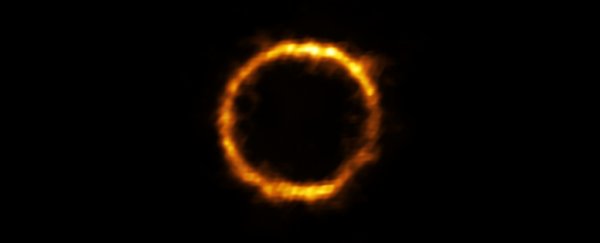A very long time ago, in the very early Universe, scientists have discovered a galaxy that seems way too advanced to have grown in the short timespan since the Big Bang. It's called SPT0418-47, and it's lurking 12.4 billion light-years away - when the Universe was just 1.4 billion years old.
What makes it special are the similarities to our own galaxy, the Milky Way. Although it lacks the characteristic curving arms of a spiral galaxy, SPT0418-47 does consist of a flat, rotating disc. It has a similar mass to the Milky Way. And, even more stunningly, it has a galactic bulge, the tightly packed concentration of stars found in the middle of most spiral galaxies.
Although earlier rotating disc galaxies have been found, SPT0418-47 is the earliest we've found that has a galactic bulge, adding to a growing body of evidence that galaxies form and evolve quite differently from how we thought they did.
"This result represents a breakthrough in the field of galaxy formation, showing that the structures that we observe in nearby spiral galaxies and in our Milky Way were already in place 12 billion years ago," said astrophysicist Francesca Rizzo of the Max Planck Institute for Astrophysics in Germany.
Back in the Universe's infancy, everything was a lot messier than it was today (not to be confused with Messier objects). Galaxies tended to be hot and blobby, with stars chaotically orbiting any which way - likely, astronomers believe, because they were colliding with each other.
But recent discoveries are starting to paint a more complex picture. It's extremely challenging to peer that far into space, but a combination of ever-advancing technology and the development of new observation techniques is helping astronomers to see what's in those far and murky reaches.
SPT0418-47 is relatively cool and faint, and would not be easy to see on its own; what gave it away was a coincidence of positioning. In between us and SPT0418-47 is a second galaxy, creating what is known as a gravitational lens.
Because the mass of the foreground galaxy is so high, it bends spacetime around it, causing light to travel on a curved path - creating a magnified, ring-shaped version of SPT0418-47, imaged using the Atacama Large Millimeter/submillimeter Array in Chile.
Astrophysicists then painstakingly reconstructed this ring of light and the motion of its gas using a new computer modelling technique, to find out the shape of the more distant galaxy. They were expecting something relatively messy, but what emerged was… well, not.
In fact, SPT0418-47 is the most Milky Way-like galaxy ever found in around the first 10 percent of the Universe's lifespan.
"What we found was quite puzzling; despite forming stars at a high rate, and therefore being the site of highly energetic processes, SPT0418-47 is the most well-ordered galaxy disc ever observed in the early Universe," said astrophysicist Simona Vegetti of the Max Planck Institute for Astrophysics.
"This result is quite unexpected and has important implications for how we think galaxies evolve."
The researchers think it's unlikely that SPT0418-47 continued to evolve into a spiral galaxy. It's more likely that it continued along a path towards the elliptical galaxy morphology, which are smoother and rounder than spirals, but are also common in the local Universe.
The fact this galaxy was already so well formed, so long ago, is yet another piece of evidence that galaxy formation processes in the early Universe didn't take as long as our models of galaxy formation suggest.
In the last few years, more massive galaxies, ultramassive galaxies, and quasar galaxies have been found in the early Universe than we ever thought possible.
Now we can add a number of "peculiarly well-formed" galaxies to that mix, suggesting that there was a lot more going on back in those turbulent early years than anyone realised, and that our models of galactic evolution may need something of an overhaul.
Future studies using the more powerful generations of telescopes to come, and techniques both current and yet to be developed, could bring those dark and distant galaxies into the light.
The research has been published in Nature.
